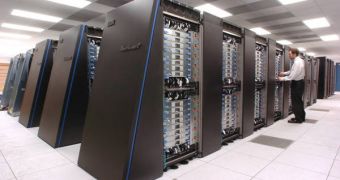It would appear that petascale supercomputers, able to perform one quadrillion (one million billion) operations per second or more, are no longer in fashion for studying black holes, the collision of galaxies, or the decay of protons in the magnetosphere, but rather for understanding things that were thought to be out of reach only a few years ago. One example for this is a future supercomputer, which will soon be constructed by experts at Virgina Tech, under a recently awarded $1.45-million grant.
The new computer “monster” will be constructed at the Virginia Tech Virginia Bioinformatics Institute (VBI) Network Dynamics and Simulation Science Laboratory (NDSSL) and will have as a purpose performing analysis on events such as disease outbreaks, the influence of the financial crisis, as well as the spread of opinions among social networks. Its massive processing power will allow for the simulation of each individual's behavior that is contained inside. Billions of such units will be modeled and observed, but the focus will remain on the interactions on group and population levels, so as to determine the path that trends, fears, opinions and feelings take to spread.
“Underpinning this project is a desire to create some of the next-generation computational tools and environments that will be needed to enable future research by social, biological and computational scientists. We anticipate unprecedented increases in scaling and execution speeds for computer processors in the years ahead,” the Principal Investigator on the project, Virginia Tech Department of Computer Sciences Professor and Deputy Director of the NDSSL, Madhav Marathe, says of the new petascale computer.
“These improvements will make it possible to look in parallel at multiple diffusions and behaviors as they evolve and influence different interactions in these extremely large social networks. We hope to be able to resolve these large networks of interactions all the way down to the level of the individual. Representing the coupled and co-evolving aspects of the networks and their constituent elements is a significant computing challenge, one that needs to be met if we are to understand these complex socio-technical phenomena,” Marathe adds.
The new MTML-Sim modeling environment will scale billion of individual components in its simulations, and will monitor the interactions between them using newly created parallel algorithms. These calculations have the ability to allow researchers the possibility to simulate many social theories in the same model at once. This is a very positive aspect, because, until now, simulations have been conducted over a single theory. In real-life, one decision or influence in turn influences others, according to the nature each human has. The MTML-Sim has the ability to replicate individual behaviors and decisions, largely due to its immense calculation power.
“Petascale computer modeling will open up many exciting opportunities to explore global multidimensional social and knowledge networks. It will enable us to theorize, simulate, and empirically validate how these dynamic networks form and evolve. The insights from this research will have unprecedented relevance to the work of policy makers interested in studying and managing a wide range of grand societal challenges,” the Co-principal investigator of the project, Noshir Contractor, explains. He is the Jane S. & William J. White professor of behavioral sciences in the School of Engineering, School of Communication and the Kellogg School of Management at the Northwestern University.

 14 DAY TRIAL //
14 DAY TRIAL //